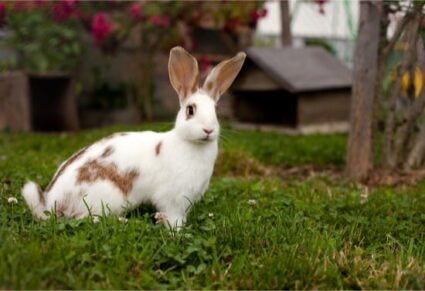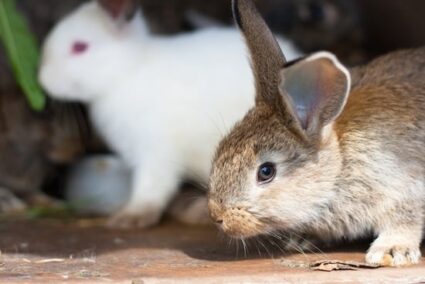There’s more to moving a rabbit outdoors than buying a hutch and placing the bunny in it. Rabbits that are used to living inside the home can struggle to adjust to life outside. It’s important to transition your rabbit slowly, so that they don’t die of shock.
Build your rabbit a strong weatherproof hutch and exercise run. Wait until the spring to move your rabbit, as sudden temperature changes can be fatal. Let them explore their outdoor enclosure for small periods each day until they’re used to it. Then, you can let them live outside permanently.
We’ll cover the potential risks of keeping a rabbit outside. We’ll share our complete guide on moving an indoor rabbit outdoors. We’ll then discuss whether rabbits can live outside year-round, and how to help rabbits survive extreme temperatures (hot and cold).
Should Rabbits Live Indoors or Outdoors?
Domestic bunnies are descended from wild European rabbits. They build huge warrens underground, to protect themselves from predators and extreme weather.
While pet rabbits don’t dig burrows, they do have some outdoor defenses.
Rabbits’ thick fur is designed to keep them warm in cold weather. They have an excellent sense of smell and hearing, so they can detect predators from far away. They’re fast enough to escape predators, providing there’s somewhere safe to run to.
Unfortunately, pet rabbits are often confined to a small outdoor area, where they can’t escape danger. It is possible to keep rabbits safe outdoors, but it requires a lot of work.
The safest place for a rabbit to live is inside the home. Provided you rabbit-proof all areas accessible to your bunny, there’s no risk. Rabbits don’t need to graze on grass as long as they have ample hay and water. Rabbits can be litter box trained.
Wild rabbits have a much shorter lifespan than domestic rabbits. They rarely reach their third birthday, whereas domestic rabbits can live up to 20 years.
Many of the factors that affect wild rabbits are also a risk to pet rabbits that live outdoors.
Dangers of Keeping Rabbits Outside
Living outside, while natural for wild animals, is risky for domesticated rabbits. There are six main dangers facing rabbits that live outdoors.
- Predators. Foxes, raccoons, badgers, cats, hawks, and owls can all kill pet rabbits. Some predators of rabbits are strong enough to break into hutches.
- Loud noises. Rabbits are easily frightened by unexpected sights and sounds. Loud noises such as fireworks, thunder, and traffic can trigger fatal heart attacks.
- Insects. Outdoor rabbits can develop flystrike, where flies infest the rabbit’s rear and maggots feast on their flesh. Fleas and mosquitos can spread diseases such as myxomatosis.
- Extreme weather. Hot temperatures in summer can cause rabbits to dangerously overheat. Freezing weather in winter can bring on hypothermia. Temperature fluctuations can be fatal.
- Loneliness. When rabbits live indoors, they get to spend time with you. Rabbits housed alone outside can become lonely, bored, sad, and depressed. They may even stop eating.
- Poisoning. Outdoor rabbits often have access to poisonous plants, such as lilies, buttercups, and ivy. Pesticides can also cause illness and even death.
Fortunately, with careful planning, it’s possible to avoid most of these dangers. The key is to anticipate what could go wrong, and prevent it.
Can You Move an Indoor Rabbit Outdoors?
Keeping your rabbit indoors is the best way to ensure their safety. But if this is impractical for you, don’t worry. Rabbits can live happy and healthy lives outside, as long as you take proper care of them.
Not all of the dangers that come with life outdoors are avoidable. You won’t be able to protect your rabbit from loud noises in your neighborhood, for example.
However, following certain steps will minimize outdoor dangers. For one, you can give them a secure, weather and predator-proof home, away from poisonous plants. Spend lots of time with them or add a second rabbit to stop them from becoming lonely.

If your rabbit is already used to living indoors, though, their transition to the outdoors can pose a problem. If you disrupt a rabbit’s environment too suddenly, they can go into shock, which can be fatal.
This can be triggered by stress. Just as traveling in the car can cause anxiety, moving home can, too. Physical factors, such as sudden fluctuations in temperature, can also be dangerous.
When a rabbit is used to living indoors, the transition to the outdoors must be done slowly. We’ve compiled a five-step guide on making the transition as easy and stress-free as possible.
How to Transition a Rabbit Outside
Before you start thinking about moving your rabbit outside, they need a safe home to move into. Your rabbit’s enclosure is the only thing protecting it from the dangers of the outdoors.
There are three main aspects to this. Your rabbit needs a sturdy hutch, a secure and spacious exercise run, and a predator-proof yard.
When your rabbit’s home is set up and ready, you can begin the transition. You’ll need to wait until the weather is mild, and introduce your rabbit to the outdoors slowly.
Follow our five steps for successfully moving an indoor rabbit outdoors.
Build a Safe Outdoor Rabbit Hutch and Run
If your rabbit is going to live outdoors, they’ll need a large, sturdy hutch or shed, plus an exercise run. A cage isn’t good enough, as it won’t protect them from the elements.
Most rabbit hutches and runs sold at pet shops aren’t suitable. They’re generally too small, and made of cheap materials that predators can break into. It’s better to build your own, from solid wood such as pine.
The hutch should have:
- At least one compartment that is entirely covered by wood on all four sides, so that your rabbit can hide.
- A sturdy wire-mesh or chain-link front for your rabbit to see out of the living quarters.
- A secure bolt or padlock for the door. Don’t use a wooden latch, as predators can break into these.
- A sloping, shingled roof, to keep the rain out.
- Legs to raise it off the ground, and a ramp going down into a large exercise run.
- Water and food bowls, plus plenty of hay. Line the hutch with a thick layer of straw bedding to make it more comfortable.
Build the hutch at least 6 feet long, 2 feet wide, and 2 feet high. The exercise run should be a minimum of 8ft x 4ft x 2ft, and have both a floor and a roof. Rabbits need regular exercise.
The entire hutch, and at least half of the run, should be in a shaded area. This will help keep your rabbit cool in the summer.
If you live in an area that has mosquitos, cover the entire hutch and run in mosquito netting. Mosquitos can transmit diseases such as myxomatosis, which can be deadly.

Predator-Proof Your Yard
If you’ve built your hutch and run well enough, they should be impenetrable to predators. However, merely seeing a predator can be dangerous in its own right.
Rabbits become highly stressed in the presence of predators, which can trigger heart attacks. For this reason, it makes sense to predator-proof your yard. Put in place as many of the following precautions as possible.
- Motion-detected sprinklers and lights. These will scare off cats, foxes, and dogs.
- A high, flat panel fence around the perimeter of the yard. These are difficult to climb. Foxes will still be able to, but dogs won’t. Attach some wire mesh to the bottom and bury it underground to stop animals from digging.
- Shiny objects, such as reflective tape or old CDs hung in tree branches. These will scare off birds such as hawks.
- Cat-repellent products, such as citrus peel. Ultrasonic noise emitters can also work, but they may stress your rabbit out.
You can never be 100% certain that no wild animals can get in. But that doesn’t mean you can’t try to make it as difficult as possible.
It’s also worth covering your rabbit’s entire enclosure with a tarpaulin at night. Many predators are active at night, and if your rabbit can’t see them, they’ll be OK.
Wait Until the Spring
Once your yard is all set up, and your rabbit’s hutch and run are assembled, you’re almost ready.
If it’s already the spring at this stage, you can introduce your rabbit to the outdoors right away. However, if it’s summer, fall or winter, you must wait until the following spring.
The reason why is all down to your rabbit’s fur coat.
Rabbits go through two big molts per year: one in the early spring, and one in the fall. In the fall, a rabbit that is used to living outdoors will grow a thick winter coat. The thickness of their coat will depend on the temperature that they anticipate it will be.
For that reason, house-rabbits that never go outdoors won’t grow a very thick coat. Their winter coat may be the same thickness as their summer coat, or only slightly thicker.
If you move your rabbit outdoors in the fall or winter, it will be too late. They won’t have time to grow a thick coat. They may get too cold over the winter, or even die from hypothermia.
If your rabbit goes outside in the summer, the sudden heat could kill them, too.
Wait until the following spring, when the weather starts to get warmer, but is still mild.
Let Your Rabbit Outside for Short Periods
Your rabbit will begin to shed their winter coat towards the end of February and the beginning of March. By mid-spring, they’ll be sporting a new, sleek coat and be ready to take on the outdoors.
When the weather has warmed up, you can begin to introduce your rabbit to the outside. Do this slowly to avoid shocking your rabbit or causing too much stress. It’s best to carry out the transition over two weeks.
In the first week, bring your rabbit outside into his run for two hours per day. One hour should be in the morning, and one in the evening. Rabbits are most active at dawn and dusk, so this is an excellent time to let them explore.

To begin with, stay with your rabbit while they’re outside. They’ll be in unfamiliar territory, and may find it stressful. Your presence will help reassure them that everything is OK.
Give your rabbit everything they need while outside, such as water, hay, and toys. A treat, such as a piece of apple, may also be a good idea. It will teach your rabbit to associate the outdoors with a pleasant experience.
In the second week, slowly up your rabbit’s outdoor time each day. Give them an extra hour each day until they’re spending 8-9 hours outdoors. At this point, keep them indoors at night.
Move Your Rabbit Outdoors Permanently
Once the two-week transition period is over, your rabbit will be ready to move outdoors permanently. Now that your rabbit is used to spending several hours each day outside, the transition won’t be hard.
The next step is to leave them outside overnight. As long as their hutch has plenty of bedding, hay, and water, they’ll be fine. And since it’s spring, you won’t have to worry about extreme temperatures.
Check on your rabbit once before you go to bed, and early the next morning. They should be pleased to see you, full of energy, and generally happy.
Top up your rabbit’s water, give them their salad and pellets, and plenty of fresh hay. You can feed your rabbit in either their run or their hutch.
After moving your rabbit outdoors, you must still spend adequate time with them every day. Rabbits are social creatures, and hate being lonely. Social interaction is essential.
If you can’t spend two hours socializing with your rabbit each day, consider getting a second rabbit. Bunnies bond very closely with each other, and keep each other company. Introducing two rabbits takes time, but when you’re done, they’ll be friends for life.
Can Rabbits Live Outside All Year Round?
Once your rabbit has successfully transitioned outside, they can live there year-round.
However, extreme temperatures can be dangerous for rabbits. In the summer and winter, you may need to take extra precautions to ensure their safety. Their hutch is the only thing preventing them from dying of heat stroke or hypothermia.
Keeping Rabbits Cool in Hot Weather
Rabbits overheat easily in hot weather due to their thick fur. Their body temperature is already high (101.3 – 103.1), and hyperthermia sets in quickly. To prevent this, try the following:
- Keep your rabbits’ hutch, and at least part of the run, in a shaded area of your yard.
- Place a large ceramic or marble tile in a shaded area for your rabbit to lie on.
- Freeze some plastic water bottles and dot them around your rabbits’ space.
- Provide your rabbit with plenty of fresh veggies and water. Place ice cubes in their water bowl to keep it cool.
- If it’s cooler inside your home than outside, bring your rabbit indoors during the hottest part of the day.
In the hot weather, keep an eye on your rabbit regularly. Signs of heat-stroke in rabbits include panting, salivating, lethargy, confusion and red ears. If you notice any of these, take your rabbit to a veterinarian immediately.
Keeping Rabbits Warm in the Winter
Rabbits are good at surviving in cold weather. But if you live somewhere with unusually cold winters, you may have to help your rabbit stay warm. Otherwise, there may be a risk of hypothermia.
- Provide your rabbit with unlimited hay. They’ll naturally bury themselves inside it to keep warm.
- Line the inside of your rabbit’s hutch with thick fleece blankets.
- Ensure the hutch is placed somewhere that rain and snow can’t get inside. Use tarpaulin over the run to protect it from rain, and windbreakers if it’s windy.
- Place a pet-safe microwavable heating pad, such as the Snugglesafe, inside your rabbit’s hutch.
- If your rabbit lives in a shed, you can use a low-wattage electric heater to keep it warm. Just make sure your rabbit can’t chew the cables.
Never use a heat lamp or electric heater inside a hutch. They’ll make it too warm. Your rabbit could easily overheat, or even get burnt.
If you have concerns about your rabbit’s temperature, take them to an experienced veterinarian.
Don’t wait for them to get too cold before bringing them in. According to the American Veterinary Medical Association, rabbits admitted to hospital with hypothermia have a substantial risk of death. For each degree colder they are, the risk doubles.


I’ve had my rabbit inside for years, she’s also able to be in the garden. She was totally litter trained, but now goes on my carpet in a particular spot whenever she can. I’ve bought odour destroyers but nothing works. I don’t know what to do. I live in a small unit. It’s come to me thinking that she’ll have to live in a hutch.